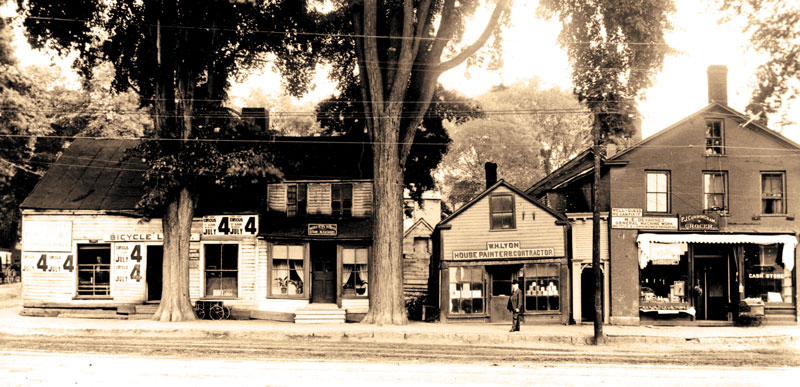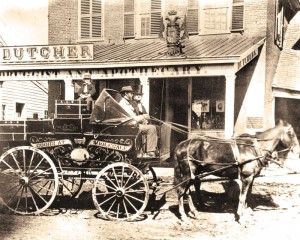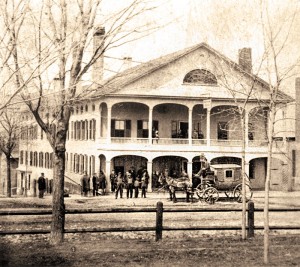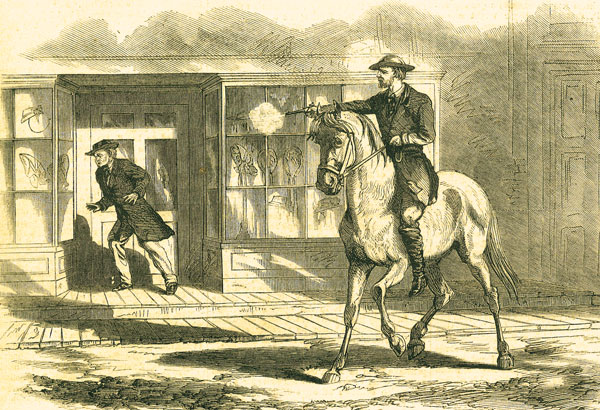
In 1901, E.D. Fuller, who witnessed the only fatal shot fired in the St. Albans Raid, stands at the approximate spot (in front of building to right of tree at center) where Elinus J. Morrison, of Manchester, N.H. was shot. Today Moonshadows and Flower Shop (at 81 N. Main), are now located.
ST. ALBANS — On break from her job as a seamstress in Miss Beattie’s Millinery Shop in St. Albans, 17-year-old Adaliza Blakely was a witness to history. On that day, nearly 150 years ago, she witnessed the shooting of a man on Main Street.

It was to Dutcher Druggist & Apothecary that mortally wounded Elinus Morrison, in St. Albans to build the Welden Hotel, was brought. Many sources of the period report that raid leader Bennett H. Young was the shooter, but no one was ever convicted.
Adaliza said the man, later identified as Elinus J. Morrison, crouched down, pressed his hands to his abdomen and leaned against the hat shop building.
Asked by Myron Wilson whether he was hurt, Morrison answered, “Yes, they have shot me through the body.”
Local doctors, when they performed an autopsy ordered by the St. Albans Board of Selectman, would find a bullet in Morrison’s abdomen.
Morrison, 52, was the only person to die as a result of the St. Albans Raid. Confederate soldiers raided St. Albans’s downtown and commercial center on Oct. 19, 1864, stealing $200,000 from three banks and escaping into Canada on stolen horses.
“I saw this man … fire twice with his pistols.”
Adaliza Blakely, on Morrison’s shooting
Susan Swasta, an archivist in the Vermont State Archive, recently uncovered three previously unheralded eyewitness accounts of Morrison’s shooting and the autopsy report determining the cause of his death. The handwritten accounts were gathered by Justice of the Peace Leonard Gilman as part of an inquiry into the cause of Morrison’s death.
Blakely reported seeing armed men on the street and hearing “the report of a pistol or some firearms.”
“I immediately turned and looked in the direction from which the report came and I saw a man with two pistols standing by his horses and about 10 or 12 feet from where Mr. Morrison stood,” Blakely said.
After the gunshot, Blakely said she saw Morrison crouch down, pressing both hands to his left side and abdomen. “I saw this man with the pistols, above mentioned, fire twice with his pistols before Mr. Morrison was wounded,” she said.
“I saw this same armed man during the forenoon of the same day that said Morrison was shot, sitting on the steps of the Tremont House, nearly opposite the shop,” Blakely reported.
Lt. Bennett Young, the leader of the raid, stayed at the Tremont House. Many accounts of the raid assume Young was the shooter, but little evidence exists to prove that assumption and Young apparently never spoke of the shooting.
Myron Wilson, 45, of St. Albans, was in the center office of the St. Albans Messenger – which it would appear now to be the Levy building on North Main Street — when his son, who was at the front of the building hollered, “There are horse thieves in the street.”
Wilson said, “I went to the window overlooking Main Street and saw a band of men opposite the offices and on either side of it, some on horseback, some on foot, engaged in unhitching horses attached to vehicles and fastened at the posts on the street. There appeared to be 15 or 20 men armed with revolvers from 12 to 15 inches long.”
Wilson went outside where he saw a man whose name the Messenger was unable to fully decipher standing with a small group of men and talking with a man on horseback holding a pistol. The armed man ordered the men inside, saying, “You go back into the building and you are all right. You don’t know what’s going on in this country. Remember Sherman.”
The raiders had been ordered by the confederacy to rob money from banks in St. Albans and, if possible, nearby Swanton as part of an effort to draw the attention of the Union Army northward. The raid was the northernmost land action of the Civil War and conducted in the waning days of the war following General Sherman’s devastating conquest of the South.
The horseman and three or four others then went south on Main Street before returning north and stopping nearly opposite Erasmus Fuller’s livery stable, according to Wilson.
“I saw armed men taking horses …”
Erasmus Fuller, witness to shooting
“After they stopped, I saw Mr. Elinus J. Morrison on the steps of Miss Beattie’s Millinery Shop about eight feet from me,” Wilson is quoted as saying. “I then saw one of the horsemen aim a pistol and fire a shot which took effect in the body of said Morrison.
“Morrison, after the pistol shot struck him, came off the steps and leaned against the corner of the building in a crouching position, and I said to him are you hurt. I saw the blood coming from one of his hands. Said he, ‘Yes, they have shot me through the body,'” said Wilson.
Wilson and another witness, the livery stable owner Fuller, then helped Morrison into the back room of a nearby drug store owned by L.S. Dutcher and Son.
Fuller, 30, of St. Albans, according to the court record, said he had been “passing south on the east side of Main Street and saw a band of men on horseback arrive with pistols coming north on said Main Street. I heard and saw said horsemen firing pistols coming north on Main Street. I saw armed men taking horses that were hitched in front of the stores and leading and riding horses from my stable on the opposite side of said Main Street.”
Fuller said he saw Morrison standing in front of the millinery shop, about five or six feet away and a little northwest of Fuller, near a large elm tree.
“I saw one of the horsemen point a pistol toward myself and said Morrison and fire three times,” reported Fuller. “Directly after this firing, I heard said Morrison exclaim, ‘They have shot me through the body.’ I turned and saw said Morrison lean against the corner of the millinery shop in crouching position. I hastened to his side and assisted in taking him to the drug store…”
Wilson and Fuller placed Morrison on a bed in the back room. They undressed him to find the location of the wound.
“I saw a wound a little above and anterior to the left hip bone and apparently penetrating the abdomen,” wrote Fuller.

Elinus Morrison had been staying in the American House when he was shot on Oct. 19, 1864 during the St. Albans Raid. He died in the American House two days later where a religious ceremony was held prior to his body being retuned to his home in Manchester, N.H.
According to St. Albans historian Carl Johnson, who wrote a thorough account of the raid in 2001, Morrison was examined by Dr. Seth R. Day and then taken to the American Hotel (at the corner of Main and Lake streets), where he had been staying. Morrison, a construction foreman from Manchester, N.H., was in St. Albans to oversee the construction of the Welden House, a large hotel then nearing completion at the northwest corner of Bank Street and Maiden Lane.
At the hotel, he was examined by Dr. John Branch. Morrison lingered for two days during which his wife arrived from New Hampshire. He died on Oct. 21.

A drawing from Leslie’s Illustrated newspaper printed soon after the St. Albans Raid provides a depiction of the shooting of Elinus Morrison outside a downtown millenary shop.
The Autopsy
That same day the St. Albans Board of Selectmen ordered S. Gilman, the Justice of the Peace, to conduct an inquest into Morrison’s death.
Gilman assembled a board of surgeons, consisting of four physicians including Day and Branch, to conduct the autopsy.
Their report was highly descriptive. “On laying open the cavity of the abdomen about six ounces of serum escaped,” the report stated. The physicians then described the damage to Morrison’s abdominal cavity, including perforations of the small intestine and evidence of a bullet wound in the colon.
The physicians “found a leaden Navy-revolver bullet laying immediately internal to the point of the last floating rib on the right side, and within the cavity of the abdomen.”
“… the wounds herein before described were the cause of the death …”
From the autopsy report
“We severally declare that in our opinion the wounds herein before described were the cause of the death of said Elinus J. Morrison,” they reported.
Gilman also took witness statements from Blakely, Fuller and Wilson.
The inquest took just a single day, with Gilman concluding: “After a careful consideration of all the testimony have the honor to report that it is my belief that the said Elinus J. Morrison received his death wound from a pistol shot fired by one of a gang of armed raiders in St. Albans Village on the 19th day of October, 1864 while the said E. J. Morrison was quietly standing or walking along the sidewalk and herewith return the same to the Franklin County Court.”
The inquest cost $46.37, with each of the physicians being paid $10 for their work on the post-mortem. Gilman was paid $3. Two dollars was spent to secure a report from a Montreal court and $0.30 was spent on stationary. It appears the witnesses may each have been paid 39 cents.
According to Johnson, a funeral service was held for Morrison at the American Hotel.
His body was returned to Manchester where services were held at his home and Morrison was buried in the Valley Cemetery in Manchester.
The raiders escaped to Canada, where some, including Young, were captured. An extradition hearing was held but the raiders were found to be enemy combatants not subject to extradition. It took years for the banks to be reimbursed for losses incurred in the raid.
By MICHELLE MONROE
St. Albans Messenger Staff Writer
Editor’s Note: The article appeared in the Feb. 15, 2014 edition of the St. Albans Messenger and appears here with the newspaper’s consent.



